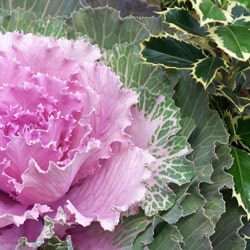King of the Cold: Ornamental Cabbage & Kale
Looking to add interest to the fall and winter landscape? This year, plant ornamental cabbage and kale for bold textures and vibrant colors.
About Ornamental Cabbage & Kale
Unlike most other annuals and perennials, these two hardy plants improve in appearance after a frost or two, which brings out more intense and brilliant colors in their foliage, perfect as an autumn accent or centerpiece plant. Identified by a number of names, including floral kale, decorative kale, ornamental-leaved kale, flowering kale, and flowering cabbage, ornamental cabbage, and kale are classified as Brassica oleracca (Acephalagroup). Offering unlimited use in the landscape, these plants have large rosettes of gray-green foliage richly variegated with cream, white, pink, rose, red, and purple. Kale leaves are frilly-edged and sometimes deeply lobed.
While typical ornamental kale and cabbage varieties are easy to find, you can also try more unusual options, including dwarf varieties as well as upright, taller hybrids that can even be used in cut arrangements.
Using These Attractive Plants
Popular in borders, grouped in planting drifts, or planted in containers for the deck or patio, ornamental cabbage and kale typically grow to 12-18″ high and wide, depending on the cultivar. Plant these specimens at least 12″ part in an area with full sun that has moist, well-drained soil. Organically rich soil with proper compost or fertilization is best to provide adequate nutrition for these lush plants. Although they are able to withstand light frosts and snowfalls, ornamental cabbage and kale will typically not survive hard freezes and are best treated as showy annuals.
The best foliage color will occur if ornamental cabbage and kale are planted in early fall as temperatures are cooling. These plants are usually attractive in the garden until Thanksgiving or even later – sometimes, they may even last until spring temperatures begin to rise. Hint: When the plants smell like cooked cabbage, it is time to pull them out!
While these plants are superficially similar to the familiar cabbage and kale vegetables popular in salads and other edible uses, it is important to note that ornamental varieties are cultivated for color and shape rather than taste. Keep them out of the kitchen and in the garden instead, and you won’t be sorry!













